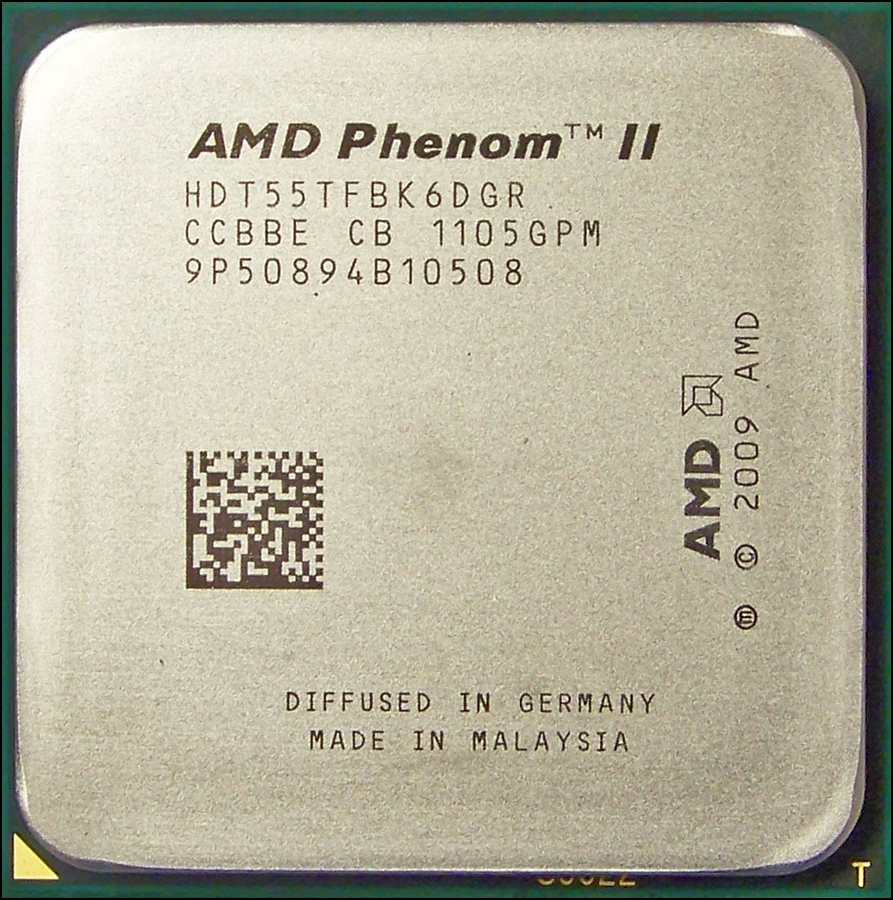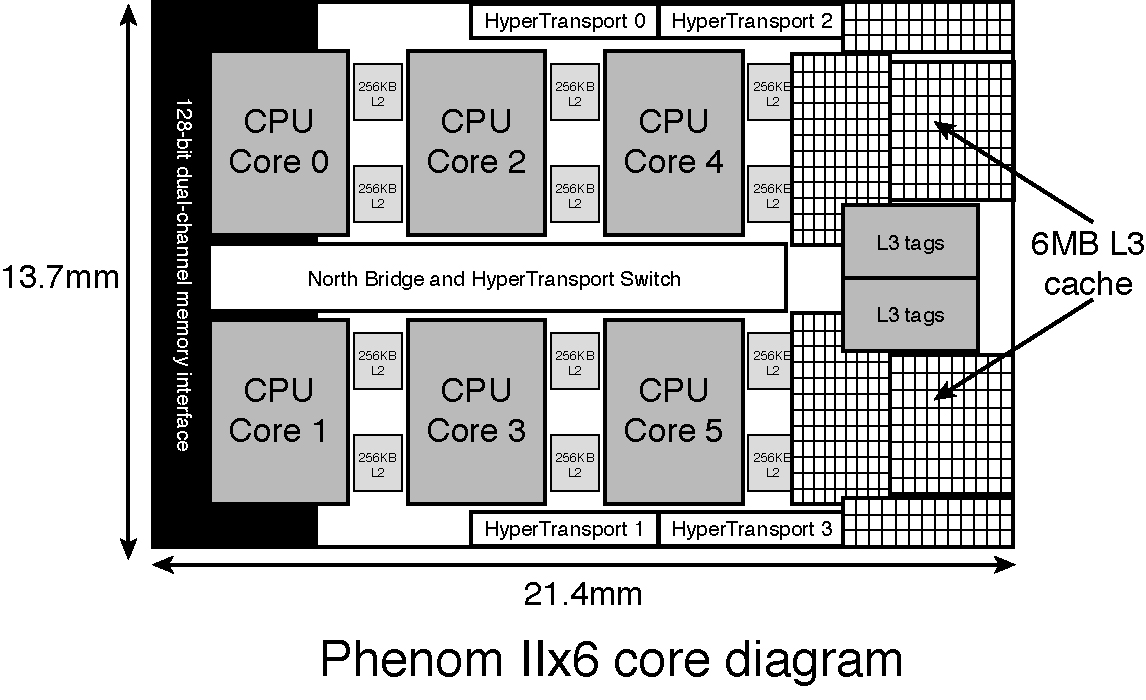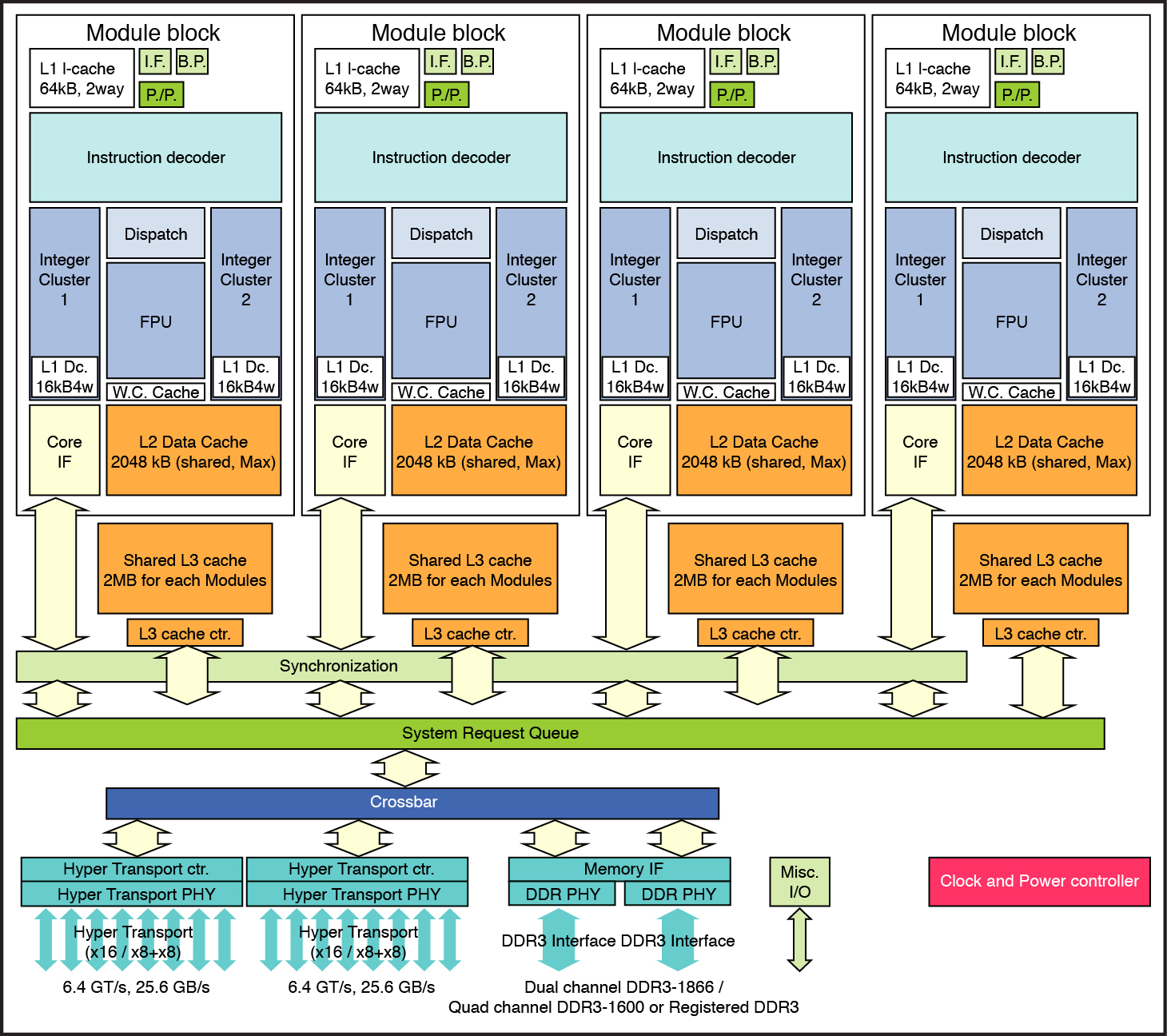Sponsored by Que Publishing
Upgrading And Repairing PCs 21st Edition: Processor Features
AMD K10, Bulldozer, Piledriver CPUs, And Fusion/HSA APUs
AMD K10 Processors (Phenom, Phenom II, Athlon II, Athlon X2, Sempron)
The K9 was a stillborn project within AMD, resulting in a skip from the K8 to the K10 architecture. The first K10 processors were the Phenom models released in November 2007.
The AMD Phenom family of processors was designed as a flexible family of chips available with 1–6 K10 cores in a single die. These include the Phenom, Phenom II, Athlon II, and some models of the Athlon X2 and Sempron processors. The initial versions used Socket AM2+, which included support for DDR2 memory. Later versions used Sockets AM3 and AM3+, which support DDR3 memory. The image below is of a Phenom II X6 processor for Socket AM3:
The Phenom X3, X4, and Athlon X2 processors were made on a 65 nm process, whereas the Phenon II, Athlon II, and Sempron 1xx processors use a smaller 45 nm process, resulting in a smaller die with overall lower power consumption and higher performance. The figure below illustrates the interior design of the Phenom II X6 processor:
The higher-end chips in this family include three, four, or six cores, L3 cache, and higher clock rates and HyperTransport bus speeds (2 GT/s).
The table below provides a detailed comparison of the various AMD K10 family processors:
Processor | Cores | CPU Speed | Turbo Core | L2 | L3 | Core | Process | Power | Socket |
|---|---|---|---|---|---|---|---|---|---|
Phenom II X6 | 6 | 2.6-3.3 GHz | Yes | 3 MB | 6 MB | Thuban | 45 nm | 95-125 W | AM3 |
Phenom II X4 | 4 | 2.9-3.5 GHz | Yes | 2 MB | 6 MB | Zosma | 45 nm | 95-125 W | AM3 |
Phenom II X4* | 4 | 2.5-3.7 GHz | No | 2 MB | 4-6 MB | Deneb | 45 nm | 95-140 W | AM3 |
Athlon II X4 | 4 | 2.2-3.8 GHz | No | 2 MB | N/A | Propus | 45 nm | 45-95 W | AM3 |
Phenom II X3 | 3 | 2.4-3.2 Ghz | No | 1.5 MB | 6 MB | Heka | 45 nm | 65-95 W | AM3 |
Athlon II X3 | 3 | 2.2-3.4 GHz | No | 1.5 MB | N/A | Rana | 45 nm | 45-95 W | AM3 |
Phenom II X2 | 2 | 2.8-3.5 GHz | No | 1 MB | 6 MB | Callisto | 45 nm | 80 W | AM3 |
Phenom II X2 | 2 | 3.4 GHz | No | 1 MB | 6 MB | Regor | 45 nm | 80 W | AM3 |
Athlon II X2 | 2 | 1.6-3.3 GHz | No | 1-2 MB | N/A | Regor | 45 nm | 25-65 W | AM3 |
Athlon II 1xxu | 1 | 1.8-2 GHz | No | 1 MB | N/A | Sargas | 45 nm | 20 W | AM3 |
Sempron 1xx | 1 | 2.7-2.9 GHz | No | 1 MB | N/A | Sargas | 45 nm | 45 W | AM3 |
Phenom X4 | 4 | 1.8-2.6 GHz | No | 2 MB | 2 MB | Agena | 65 nm | 65-140 W | AM2+ |
Phenom X3 | 3 | 1.9-2.5 GHz | No | 1.5 MB | 2 MB | Toliman | 65 nm | 65-95 W | AM2+ |
Athlon X2 | 2 | 2.3-2.8 GHz | No | 1 MB | 2 MB | Kuma | 65 nm | 95 W | AM2+ |
*Model 840 has no L3 cache
- Zosma = Thuban with two cores disabled
- Propus = Deneb with no (or disabled) L3 cache
- Heka = Deneb with one core disabled
- Rana = Propus with one core disabled
- Callisto = Deneb with two cores disabled
- Toliman = Agena with one core disabled
- Kuma = Agena with two cores disabled
AM3 processors can also be used in Socket AM2+ motherboards with appropriate BIOS update.
AMD “Bulldozer” and “Piledriver” FX Processors
AMD introduced its follow-up to its K10 architecture, the Bulldozer architecture, in October 2011. Although FX processors in this family use the same Socket AM3+ as late-model K10 processors do, the internal design of Bulldozer processors is very different from its predecessors.
Note: Bulldozer is also known as K11, but Bulldozer is the more common name for this architecture.
Bulldozer processors are modular. Each module contains a single L1 instruction cache, a multi-branched instruction decoder, and a multilayer dispatch controller. The dispatch controller is connected to two integer processing clusters and a single floating point unit. The results are connected to a write coalescing cache, a core interface unit, and up to 2 MB of L2 cache. A module is commonly referred to as a dual-core processor, although only the integer clusters are dualed. A Bulldozer CPU includes 8 MB of L3 cache memory, and Bulldozer CPUs were manufactured in eight-core, six-core, and four-core versions, known collectively as Zambezi.
Other features in Bulldozer include AMD’s Turbo Core (a built-in overclocking feature) and new CPU instructions (AES, AVX, FMA4, and XOP). These instructions support faster encryption, floating-point math, rendering, and video transcoding on software optimized for them. Bulldozer uses a 32 nm manufacturing process, compared to the 45 nm used by most K10-class parts. FX processors based on Bulldozer are completely unlocked for easier overclocking. AMD sells an optional liquid cooler for FX Bulldozer and Piledriver CPUs.
Bulldozer processors are optimized for multithreaded software, but performance benchmarks were disappointing, as most applications were not optimized for Bulldozer’s new architecture. Further specifications for Bulldozer processers are listed in the table below:
Processor | Cores | CPU Speed | Turbo Core | L2 | Power |
|---|---|---|---|---|---|
FX 81xx | 8 | 3.1-3.6 GHz | Yes | 4 MB | 125 W |
FX 61xx | 6 | 3.3 GHz | Yes | 3 MB | 95 W |
FX 41xx | 4 | 3.8 GHz | No | 2 Mb | 125 W |
AMD introduced an improved version of its Bulldozer architecture, Piledriver, in October 2012. Compared to Bulldozer, Piledriver includes these improvements:
- More accurate branch predictor
- Support for the latest integer instructions FMA4 and F16C
- Improved L1 and L2 cache designs
- Faster clock speeds
The table below lists the FX processors using Piledriver microarchitecture. These processors use the Vishera core.
Processor | Cores | CPU Speed | L2 | Power |
|---|---|---|---|---|
FX 83xx | 8 | 3.5-4 GHz | 4 MB | 125 W |
FX 63xx | 6 | 3.5 GHz | 3 MB | 95 W |
FX 43xx | 4 | 3.8 GHz | 2 MB | 95 W |
AMD Fusion/HSA (Heterogeneous Systems Architecture) APUs
Fusion was the original name for a variety of AMD mobile, desktop, and server processors with in-core graphics, which are now classified under the Heterogeneous Systems Architecture (HSA) designation. AMD refers to these processors as advanced processing units (APUs).
Note: AMD dropped the Fusion name after it was discovered that a Swiss firm, Arctic (originally Arctic Cooling), had been using Fusion for its power supply products since 2006, hence the change to the HSA designation.
AMD has released several lines of APUs, including the C-series (primarily for notebooks) and the E-series (used in notebooks and a few very low-cost desktops). However, the primary product line for desktops is the A-series, which has used two core designs. The initial A-series designs use the Llano core, based on Bulldozer, but with no L3 cache, while the second series uses the Trinity core, based on Piledriver, but again with no L3 cache. The Llano core uses Socket FM1 and includes models with two, three, or four cores and up to 4 MB of L2 cache. The Trinity core uses Socket FM2 and provides faster clock speeds, better GPU performance, and better thermal management. It also features two to four cores with up to 4 MB of L2 cache. The table below compares these processors:
Processor | Cores | CPU Speed | Turbo Core | L2 | GPU | Power | Unlocked | Core |
|---|---|---|---|---|---|---|---|---|
A10-5800K | 4 | 3.8 GHz | Yes | 4 MB | HD 7600D | 100 W | Yes | Trinity |
A10-5700 | 4 | 3.4 GHz | Yes | 4 MB | HD 7600D | 65 W | No | Trinity |
A8-5600K | 4 | 3.6 GHz | Yes | 4 MB | HD 7560D | 100 W | Yes | Trinity |
A8-5500 | 4 | 3.2 GHz | Yes | 4 MB | HD 7560D | 65 W | No | Trinity |
A8-3870K | 4 | 3.0 GHz | No | 4 MB | HD 6550D | 100 W | Yes | Llano |
A8-3850 | 4 | 2.9 GHz | No | 4 MB | HD 6550D | 100 W | No | Llano |
A8-3800 | 4 | 2.4 GHz | Yes | 4 MB | HD 6550D | 65 W | No | Llano |
A6-5400K | 2 | 3.6 GHz | Yes | 1 MB | HD 7540D | 65 W | Yes | Trinity |
A6-3670K | 4 | 2.7 GHz | No | 4 MB | HD 6530D | 100 W | Yes | Llano |
A6-3650 | 4 | 2.6 GHz | No | 4 MB | HD 6530D | 100 W | No | Llano |
A6-3600 | 4 | 2.1 GHz | Yes | 4 MB | HD 6530D | 65 W | No | Llano |
A6-3500 | 4 | 2.1 GHz | Yes | 3 MB | HD 6530D | 65 W | No | Llano |
A4-5300 | 3 | 3.4 GHz | Yes | 1 MB | HD 7480D | 65 W | No | Trinity |
A4-3400 | 2 | 2.7 GHz | No | 1 MB | HD 6410D | 65 W | No | Llano |
A4-3300 | 2 | 2.5 GHz | No | 1 MB | HD 6410D | 65 W | No | Llano |
Current page: AMD K10, Bulldozer, Piledriver CPUs, And Fusion/HSA APUs
Prev Page Intel Core ix-Series And Atom ProcessorsGet Tom's Hardware's best news and in-depth reviews, straight to your inbox.
Tom's Hardware is the leading destination for hardcore computer enthusiasts. We cover everything from processors to 3D printers, single-board computers, SSDs and high-end gaming rigs, empowering readers to make the most of the tech they love, keep up on the latest developments and buy the right gear. Our staff has more than 100 years of combined experience covering news, solving tech problems and reviewing components and systems.



